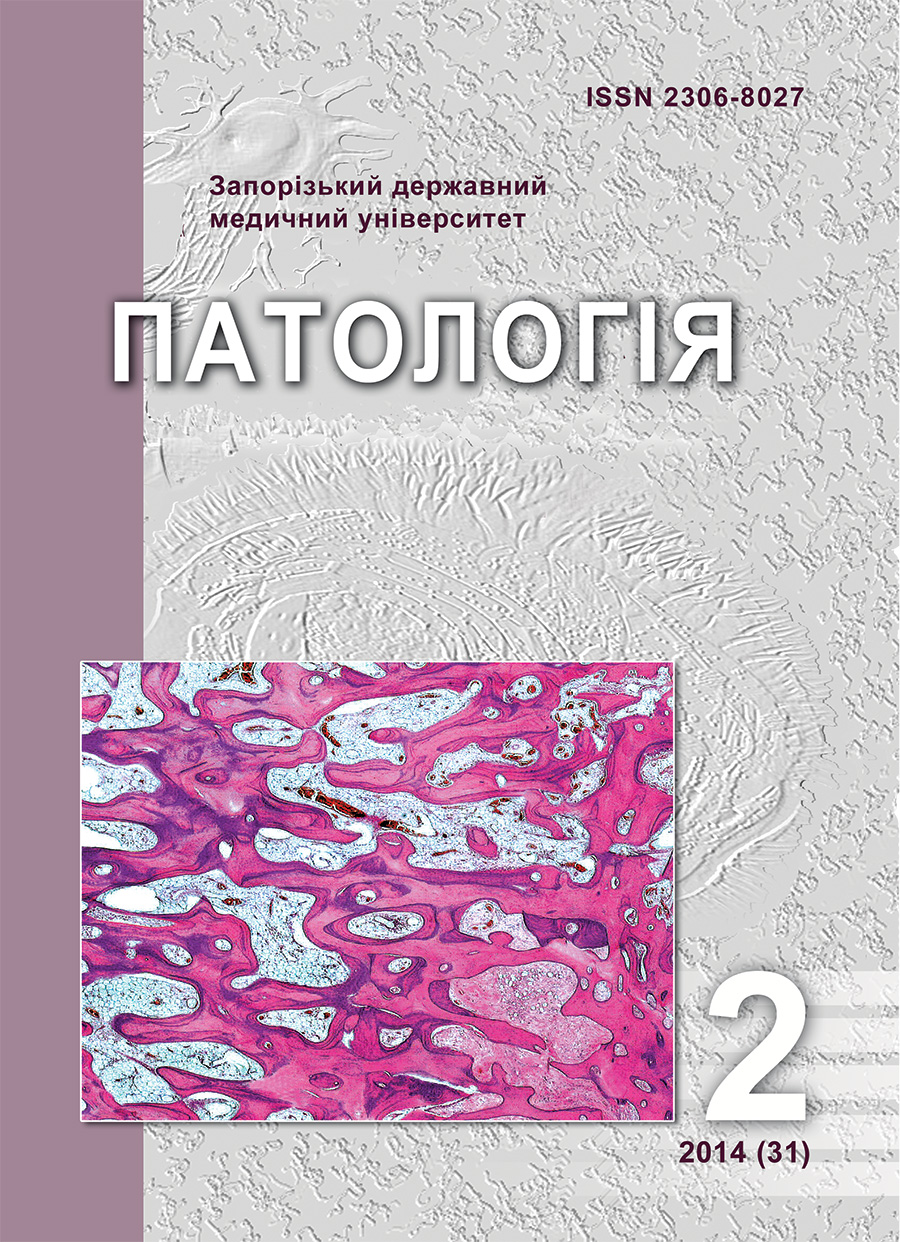Analysis and selection of experimental models of osteoarthritis
DOI:
https://doi.org/10.14739/2310-1237.2014.2.28544Keywords:
Osteoarthritis, Pathogenesis, Experimental animal model, Articular cartilage, Subchondral boneAbstract
Aim. The aim of the work is to examine relevant literature on different patterns of experimental osteoarthritis and choose the most acceptable one for providing its preclinical investigation.
Methods and results. Osteoarthritis (OA) is one of the common forms of joint disease. OA is mainly in the head of the top five causes of disability. Notwithstanding a great number of revealed predisposing factors and the involvement of mechanical distress, the exact pathogenesis of OA is still a subject of investigation. Particularly the earliest changes are largely unknown, because they appear long before clinical manifestation, and that is why they are not able to be studied in humans. The great number of OA researches is devoted to the methods of early detection and developing strategies of its treatment. Animal experimental models help in investigating mechanisms of OA development and finding morphological, physiological criteria for strict diagnosis of OA.
Conclusion. It was settled that small animal experimental models of OA are more suitable for preclinical investigations of OA pathogenesis: its genetic and molecular mechanisms; large animal experimental models of OA allow to investigate biomechanical changes of the joint and to provide intraarticular interventions. Methods which are necessary for perfect investigation of the joint are also described in the article.
References
Aspden, R. M. (2008). Osteoarthritis: Problems of Growth Not Decay? Rheumatology, 47 (10), 1452–1460. doi: 10.1093/rheumatology/ken199.
Blair-Levy, J. M., Watts, C. E., Fiorientino, N. M., Dimitriadis, E. K., Marini, J. C., & Lipsky, P. E. (2008). A type I collagen defect leads to rapidly progressive osteoarthritis in a mouse model. Arthritis & Rheumatism, 58(4), 1096–1106. doi: 10.1002/art.23277.
Bondeson, J., Blom, A. B., Wainwright, S., Hughes, C., Caterson, B., & van den Berg, W. B. (2010). The Role of Synovial Macrophages and macrophage-Produced Mediators in Driving Inflammatory and destructive Responses in Osteoarthritis. Arthritis & Rheumatism, 62(3), 647–657. doi: 10.1002/art.27290.
Brandt, K. D., Radin, E. L., Dieppe, P. A., & van de Putte L. (2006). Yet more evidence that osteoarthritis is not a cartilage disease. AnnRheumDis, 65, 1261–1264. doi:10.1136/ard.2006.058347.
Chen, A., Gupte, C., Akhtar, K., Smith, P. & Cobb, О. (2012). The Global Economic Cost of Osteoarthritis: How the UK Compares. Arthritis, 2012, 1–6. doi:10.1155/2012/698709.
Chillemi, C., & Franceschini, V. (2013). Shoulder Osteoartritis. Arthritis, 2013, 11. doi:10.1155/2013/3.
Findlay, D. M. (2007).Vascular pathology and osteoarthritis. Rheumatology, 46, 1763–1768.
Goldring, M. B., & Marcu, K. B. (2009).Cartilage homeostasis in health and rheumatic diseases. Arthritis Research & Therap., 11(3), 224. doi:10.1186/ar2592.
Gregory, M. H., Capito, N., Kuroki, K., Stoker, A. M., Cook, J. L. & Sherman, S. L. (2012). A review of Translational Animal Models for Knee Osteoarthritis. Arthritis, 2012, 14. doi:10.1155/2012/764621.
Kaissi, A. A., Klaushofer, K., & Grill, F. (2009). Osteochondritis Dissecans and Osgood Schlatter Disease in a Family with Stickler Syndrome. Pediatric Rhematology, 7(1), 4. doi:10.1186/1546-0096-7-4.
Kim, H. J., & Kirsch, T. (2008). Collagen/Annexin V Interactions regulate chondrocyte mineralization. J. Biol. Chem., 283(16), 10310–10317. doi: 10.1074/jbc.M708456200.
Lawrence, R. C., Felson, D. T., Helmick, C. G., et al. (2008). Estimates of the prevalence of arthritis and other rheumatic conditions in the United States Part II, Arthritis & Rheumatism, 58(1), 26–35. doi: 10.1002/art.23176.
Masbergen, S. C., & Lafeber, F. P. J. G. (2009). Animal Models of Osteoarthritis –Why Choose a Larger Model? Mastbergen_US_Cardiology_book,_temp 20/11/2009, 11–14.
Masbergen, S. C., & Lafeber, F. P. J. G. (2011). Changes in Subchondral Bone Early in the Development of Osteaarthritis. Arthritis & Rheumatism, 63(9), 2561–2563.
Muraoka, T., Hagino, H., Okano, T., Enokida, M., & Teshima, R. (2007). Role of Subchondral Bone in Osteoarthritis Development. Arthritis & Rheumatism, 56(10), 3366–3374. doi: 10.1002/art.22921.
Pound, P., Ebrahim, S., Sandercock, P., Bracken, M. B. & Roberts, I. (2004). Where is the evidence that animal research benefits humans? BMJ, 328, 514–517.
Roemer, F. W., Crema, M. D., Trattnig, S., Guermazi, A. (2011). Advances in Imaging of Osteoarthritis and Cartilage. Radiology, 260(2), 332–354. doi: 10.1148/radiol.11101359.
Sakkas, L. I., & Platsoucas, C. D. (2007). The role of T Cells in the Pathogenesis of Osteoarthritis. Arthritis & Rheumatism, 56(2), 409–424. doi: 10.1002/art.22369.
Tiraloche, G., Girard, C., Couinard, L., Sampalis, J., Moquin, L, Ionescu, M., Reiner, A., et al. (2005). Effect of Oral Glucosamine on Cartilage Degradation in a Rabbit Model of Osteoarthritis. Arthritis & Rheumatism, 52(4), 1188–1128.
Hruhorieva, O. A., & Voloshyn, M. A. (2011). Eksperymentalne modeliuvannia nedyferenciiovanoi dysplazii spoluchnoi tkanyny shliakhom porushennia antuhennoho homeostasu v systemi maty – platsenta – plid. [Experimental modeling of undifferentiated connective tissue dysplasia by instituting antigenic homeostasis in the mother-placenta-fetus]. Patolohia, 8(2), 39–42. [in Ukrainian].
Downloads
How to Cite
Issue
Section
License
Authors who publish with this journal agree to the following terms:
Authors retain copyright and grant the journal right of first publication with the work simultaneously licensed under a Creative Commons Attribution License that allows others to share the work with an acknowledgement of the work's authorship and initial publication in this journal.

Authors are able to enter into separate, additional contractual arrangements for the non-exclusive distribution of the journal's published version of the work (e.g., post it to an institutional repository or publish it in a book), with an acknowledgement of its initial publication in this journal.
Authors are permitted and encouraged to post their work online (e.g., in institutional repositories or on their website) prior to and during the submission process, as it can lead to productive exchanges, as well as earlier and greater citation of published work (SeeThe Effect of Open Access).

